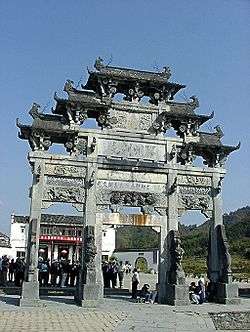Huizhou (region)
| Huizhou 徽州 | |
|---|---|
| Region | |
|
Xidi, a World Heritage Site, is a village in Huizhou that was built by a merchant family during the Ming Dynasty | |
| Country | China |
| Province | Anhui and Jiangxi |
| Area | |
| • Total | 13,870 km2 (5,360 sq mi) |
| Population (2010) | |
| • Total | c. 1,984,000 |
Huīzhōu (Chinese: 徽州) is a historical region in southeastern China. It corresponds to the southernmost part of Anhui Province (Huangshan City and Jixi County) plus Wuyuan County in northeastern Jiangxi Province. Anhui, the name of the province, is a portmanteau word combining the first characters of Anqing and Huizhou.
History
During the Song dynasty (1211), Huizhou was named from Shezhou or She Prefecture (歙). The prefecture remained intact for about 800 years with six counties: Shexian County (歙县), Yixian County (黟县), Xiuning (休宁), Qimen (祁门), Jixi (绩溪), and Wuyuan (婺源).
Geography
Huizhou is a mountainous region in the south of Anhui province. Huizhou is also well known for the scenic Huangshan Mountains.
Economy
Since the Ming dynasty, the merchants of Huizhou, collectively known in Chinese as Huishang (徽商; pinyin: Huīshāng) were renowned for their economic prowess. During the Ming and Qing dynasties, they formed a formidable political force both regionally and nationally.
Culture
Huizhou has its own distinct culture as well as spoken Chinese form, known as Huizhou and recognized as one of the main subdivisions of spoken Chinese. Peking Opera originates in a local opera of Huizhou.
Hui cuisine, known for wide use of wild herbs, is one of eight main Chinese cuisines.
Architecture
Huizhou is famous for ancient streets and buildings, such as ancestral temple, memorial archway. Residential buildings in Huizhou attach importance to Fengshui and yinyang.
Notable people
- Zhu Xi (1130-1200)
- Huang Binhong (1865-1955)
- Hu Shih (1891-1962)
- Tao Xingzhi (1891-1946)
- Hu Xueyan (1823-1885)
- Hu Zongxian (1512-1565)
- Zhan Tianyou (1861-1919)
- Sai Xinhua (1872-1936)
- Jiang Zemin
- Hu Jintao
